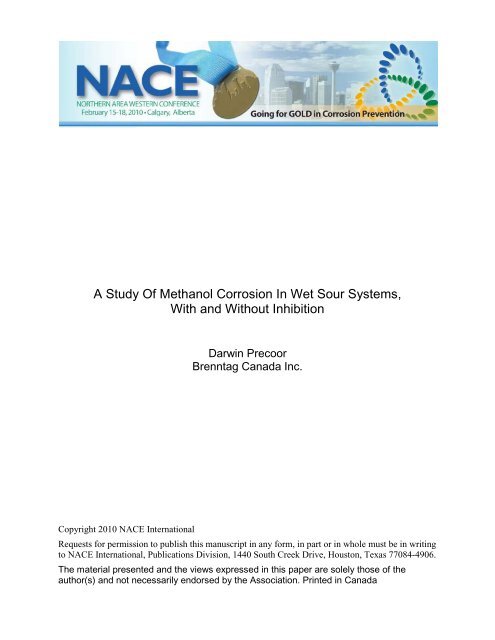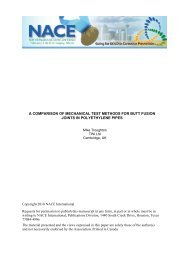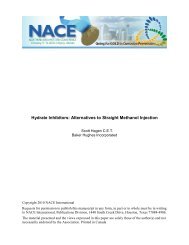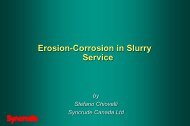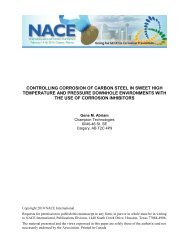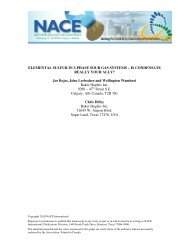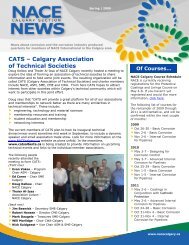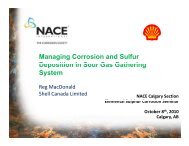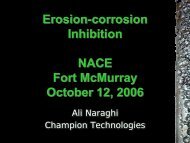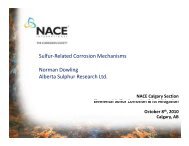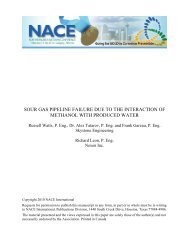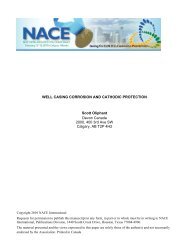Methanol Corrosion in Sour Systems - NACE Calgary
Methanol Corrosion in Sour Systems - NACE Calgary
Methanol Corrosion in Sour Systems - NACE Calgary
Create successful ePaper yourself
Turn your PDF publications into a flip-book with our unique Google optimized e-Paper software.
A Study Of <strong>Methanol</strong> <strong>Corrosion</strong> In Wet <strong>Sour</strong> <strong>Systems</strong>,<br />
With and Without Inhibition<br />
Darw<strong>in</strong> Precoor<br />
Brenntag Canada Inc.<br />
Copyright 2010 <strong>NACE</strong> International<br />
Requests for permission to publish this manuscript <strong>in</strong> any form, <strong>in</strong> part or <strong>in</strong> whole must be <strong>in</strong> writ<strong>in</strong>g<br />
to <strong>NACE</strong> International, Publications Division, 1440 South Creek Drive, Houston, Texas 77084-4906.<br />
The material presented and the views expressed <strong>in</strong> this paper are solely those of the<br />
author(s) and not necessarily endorsed by the Association. Pr<strong>in</strong>ted <strong>in</strong> Canada
A Study Of <strong>Methanol</strong> <strong>Corrosion</strong> In Wet <strong>Sour</strong> <strong>Systems</strong>,<br />
With And Without Inhibition.<br />
Darw<strong>in</strong> Precoor<br />
Brenntag Canada Inc.<br />
3124 54 th Ave. SE<br />
<strong>Calgary</strong> Alberta T2C 0A8<br />
Abstract<br />
The corrosivity of methanol <strong>in</strong> a sour system is impacted by the concentration of<br />
methanol, the presence of <strong>in</strong>hibitors, and the dilution with br<strong>in</strong>e. <strong>Methanol</strong> is known to<br />
cause corrosion with<strong>in</strong> a system; however, the corrosivity is typically related to the loss<br />
of <strong>in</strong>hibitor films and not so much on the methanol itself. This study exam<strong>in</strong>es the<br />
corrosive role of mostly pure methanol. Understand<strong>in</strong>g how methanol impacts corrosion<br />
rates can aid <strong>in</strong> the selection of products that can positively offset the effects of<br />
methanol and reliably <strong>in</strong>hibit the system.<br />
Keywords<br />
Inhibited methanol, batch <strong>in</strong>hibitor, corrosion, electrochemistry, LPR<br />
1
1.0 INTRODUCTION<br />
Techniques that are presently employed by the oil and gas <strong>in</strong>dustry for the prevention<br />
and/or dissociation of gas hydrates are: 1) remove the water to lower the dew po<strong>in</strong>t, 2)<br />
control the temperature of the system, 3) control the pressure of the system, 4) use<br />
methanol, 5) use hydrate <strong>in</strong>hibitors, or 6) under severe conditions, a comb<strong>in</strong>ation of the<br />
above methods may be necessary.<br />
To date, the preferred alternative for hydrate control has been to utilize large volumes of<br />
methanol.<br />
2.0 HYDRATES AND CLATHRATES<br />
In solid crystall<strong>in</strong>e hydrates, hydrogen bond<strong>in</strong>g becomes important <strong>in</strong> addition to ion<br />
dipole attractions. Often the water molecules serve to fill <strong>in</strong> the <strong>in</strong>terstices and b<strong>in</strong>d<br />
together a structure which would otherwise be unstable because of the disproportionate<br />
size of the cation and anion.<br />
In some cases hydrates form with neutral molecules (methane, ethane, etc.) The basic<br />
build<strong>in</strong>g block for this type of structure is typically a dodecahedron formed from 20<br />
molecules of water. When these cage like structures pack together to form larger units,<br />
relatively large voids are formed with<strong>in</strong> and it is <strong>in</strong> these spaces that the gas molecules<br />
reside. These gas hydrates <strong>in</strong> which the “guest” molecules are not bound chemically,<br />
but are reta<strong>in</strong>ed by the structure of the host, are called clathrates.<br />
3.0 HYDRATE CONTROL THROUGH USE OF METHANOL<br />
Gas hydrates form when produced hydrocarbon gas and water are subjected to<br />
extreme pressures and temperatures, often associated with production facilities. The<br />
po<strong>in</strong>t at which hydrates will form depends on the gas composition, fluid(s) production,<br />
the temperature and pressure of the system. Hydrates are a complex crystal similar to<br />
that of frozen water. The difference is that hydrates have a molecule of produced gas,<br />
usually methane, <strong>in</strong>corporated <strong>in</strong>to the structure.<br />
2
Traditionally, methanol has been used to control the formation of hydrates. <strong>Methanol</strong><br />
works by lower<strong>in</strong>g the temperature at which the hydrates form at a given pressure<br />
(thermodynamically). The critical temperature must be lowered to below that of<br />
operat<strong>in</strong>g temperature for methanol to be effective. To control severe hydrate<br />
problems, large quantities of methanol are often needed to reduce the hydrat<strong>in</strong>g<br />
temperature to an acceptable level.<br />
4.0 DETRIMENTAL EFFECTS OF LARGE METHANOL CONSUMPTION<br />
The application of large volumes of methanol is an effective solution for hydrate control.<br />
However, there may be consequences that can impact the system <strong>in</strong>tegrity and perhaps<br />
the service life of the pipel<strong>in</strong>e.<br />
This paper is <strong>in</strong>tended to share some of the corrosion evaluations study<strong>in</strong>g methanol<br />
corrosion as performed <strong>in</strong> controlled environments <strong>in</strong> the laboratory.<br />
5.0 TEST PROTOCOL<br />
Test cells: All of the evaluations were performed <strong>in</strong> high temperature, high pressure,<br />
stirrable autoclaves constructed of Hastelloy C256. The autoclave total volume is about<br />
500 ml, of which 350 ml was liquid and the rema<strong>in</strong>der was headspace. The autoclaves<br />
are fitted with three electrodes to facilitate electrochemical / LPR monitor<strong>in</strong>g. The<br />
reference electrode was manufactured from Hastelloy C256 and the work<strong>in</strong>g / auxiliary<br />
electrodes were 1018 CS as supplied by Caproco.<br />
<strong>Methanol</strong>: The methanol used <strong>in</strong> the experiments was a regular commercial grade<br />
conta<strong>in</strong><strong>in</strong>g a purity of 99.85%. The methanol received no special treatment. It was not<br />
stored <strong>in</strong> an oxygen free environment, the methanol was not purged to remove oxygen<br />
or other entra<strong>in</strong>ed gas(es) and it was not filtered. There were no compounds (i.e. salt<br />
etc) or products added that we would not normally blend <strong>in</strong>to the methanol solutions.<br />
The <strong>in</strong>tent was to evaluate the methanol as it would have been applied <strong>in</strong> the field. The<br />
3
only part of typical field application that was not replicated was the use of a chemical<br />
pump.<br />
Acid Gas: Pre-blended 50:50 H 2 S:CO 2 was used <strong>in</strong> some of the test<strong>in</strong>g and other test<br />
protocols called for 99.6% H 2 S or 99.9% CO 2 all grades of which are commercially<br />
available.<br />
Pressure Cycle<br />
A pressure cycle is def<strong>in</strong>ed as a safe connection of the gas cyl<strong>in</strong>der to the autoclave,<br />
where the gas bottle / regulator valves are opened to allow the sealed autoclave to fill /<br />
equilibrate to the regulated pressure of the cyl<strong>in</strong>der. Typically when aqueous fluids are<br />
utilized <strong>in</strong> the autoclave, the regulated pressure is achieved relatively quickly and the<br />
valves can be closed (for safety reasons) for the equilibrium period. The equilibrium<br />
period allows the gas <strong>in</strong> the head space to equilibrate <strong>in</strong>to the test fluids. As the<br />
pressure <strong>in</strong> the headspace subsides, the pressure can be reapplied with another<br />
pressure cycle. After a relatively short period of time and several pressure cycles the<br />
headspace pressure rema<strong>in</strong>s constant and the fluids are charged with the select gas.<br />
This procedure is followed because of the toxic effects of H 2 S and it m<strong>in</strong>imizes the<br />
volume of gas released <strong>in</strong> the event of a component failure.<br />
Note: Hydrogen sulphide (H 2 S) is a highly toxic, flammable, colourless gas that has the<br />
smell of rotten eggs and even at very low concentrations, exposure can result <strong>in</strong> <strong>in</strong>jury<br />
or death. This product must be handled by tra<strong>in</strong>ed personnel and used <strong>in</strong> a suitable<br />
environment to protect human life.<br />
6.0 CORROSION EVALUATIONS - OBSERVATIONS<br />
Test 1<br />
Test Parameters - Test 1<br />
Gas 50:50 H 2 S:CO 2<br />
Pressure<br />
Two pressure levels - 50 & 100 psi<br />
Fluids<br />
<strong>Methanol</strong> – un<strong>in</strong>hibited<br />
Temperature<br />
35 o C<br />
Test Duration<br />
~27 hours<br />
4
The corrosive effects of pure methanol on carbon steel <strong>in</strong> a laboratory sett<strong>in</strong>g were<br />
uncerta<strong>in</strong> and a literature search showed that there was m<strong>in</strong>imal (none at the time)<br />
published material on the subject. The first test, (<strong>in</strong>clud<strong>in</strong>g only methanol, H 2 S:CO 2 acid<br />
gas and carbon steel), was <strong>in</strong>tended to be a short duration, two pressure, typical system<br />
temperature experiment. S<strong>in</strong>ce most sour systems also conta<strong>in</strong> CO 2, the test was run<br />
with a 50:50 preblend mix of H 2 S:CO 2 . The autoclaves were set at 50 and 100 psi to<br />
reflect the typical partial pressures that were observed at that time. The test<br />
temperature was about 35 o C. The autoclaves were prepared us<strong>in</strong>g normal assembly<br />
procedures and the methanol conta<strong>in</strong>ed no <strong>in</strong>hibitor. The test cells were briefly<br />
prepurged with anaerobic CO 2 to purge the headspace of oxygen and then sealed and<br />
pressured / equilibrated with the premix 50:50 H 2 S:CO 2 acid gas.<br />
The normal pressure cycl<strong>in</strong>g procedure of an autoclave requires a s<strong>in</strong>gle or manifold<br />
type of mechanical connection to the selected gas bottle. Normally, when aqueous<br />
fluids (water or br<strong>in</strong>e) are placed <strong>in</strong> the autoclave, only several cycles of pressure /<br />
equilibration were required to saturate the br<strong>in</strong>e and the autoclave would approach the<br />
desired test pressure <strong>in</strong> a relatively short period of time.<br />
Our observations showed the acid gas purge sequence for the methanol solution as<br />
be<strong>in</strong>g unmistakably different from a rout<strong>in</strong>e aqueous purge. The methanol test solution<br />
absorbed the H 2 S:CO 2 acid gas at an <strong>in</strong>credible rate and required extensive pressure<br />
cycl<strong>in</strong>g to f<strong>in</strong>ally achieve the target pressure <strong>in</strong> the autoclave. The <strong>in</strong>creased volume of<br />
acid gas required to reach equilibrium (with methanol versus water) could not be<br />
quantified. However, anecdotal evidence <strong>in</strong>dicated that the acid gas solubility <strong>in</strong><br />
methanol was approach<strong>in</strong>g an order of magnitude greater than water based fluids.<br />
The methanol was commercially pure and was not expected to be overly conductive<br />
suggest<strong>in</strong>g LPR measurements may be of limited value. Never-the-less, the<br />
electrochemical LPR corrosion rates were collected every 30 m<strong>in</strong>utes for the test<br />
duration. Over the course of the test, the LPR data <strong>in</strong>dicated very low corrosivity (not<br />
5
unexpected - Figure 1). The cell set at 50 psi showed lower LPR corrosion rates than<br />
the 100 psi cell (0.3 mpy versus 0.45 mpy). The test was term<strong>in</strong>ated at about 27 hours<br />
as the external <strong>in</strong>dications suggested limited corrosion activity was transpir<strong>in</strong>g with<strong>in</strong> the<br />
test cell.<br />
The gas de-pressurization cycle was the reverse of the pressur<strong>in</strong>g cycle and a large<br />
volume of gas exited the autoclaves before they were safe to open. The blow down<br />
procedure required much more time than what was normally experienced when water<br />
based fluids were utilized. Regrettably, the means to actually measure the exit<strong>in</strong>g<br />
volume of gas was lack<strong>in</strong>g and it could only be qualitatively noted that it was<br />
significantly greater than when just water based/ br<strong>in</strong>e test solutions were evaluated.<br />
The methanol fluid rema<strong>in</strong>ed colourless and conta<strong>in</strong>ed suspended particulates. The<br />
methanol cont<strong>in</strong>ued to effervesce for an extended time period; much greater than that<br />
observed with aqueous fluids. The electrodes were removed and results documented<br />
(Figure 2), the electrode solids were recovered and then the electrodes were cleaned /<br />
weighed. The test results showed the lower gas pressure cell (50 psi) generated a 27<br />
mg weight loss (48 mpy) whereas the higher pressure cell (100 psi) showed a 20 mg<br />
weight loss (35 mpy – Figure 3). This was the reverse of what was observed on the<br />
LPR. All of the corrosion damage appeared uniform and no localized <strong>in</strong>dications were<br />
observed.<br />
The black solids recovered from the electrodes were analyzed by x-ray diffraction and<br />
they were identified as primarily mack<strong>in</strong>awite. As shown <strong>in</strong> Figure 2, the solid volume<br />
was substantial; they were very brittle and ma<strong>in</strong>ta<strong>in</strong>ed the cyl<strong>in</strong>drical shape even after<br />
detachment from the electrode. Normally iron sulfides are relatively adherent to steel<br />
and have never been observed to detach <strong>in</strong> a form that reta<strong>in</strong>s the shape of the<br />
corrod<strong>in</strong>g material.<br />
6
Test 2<br />
Test Parameters - Test 2<br />
Gas 50:50 H 2 S:CO 2<br />
Pressure<br />
50 psi<br />
Fluids<br />
Inhibited & un<strong>in</strong>hibited <strong>Methanol</strong>, 150K Cl - high TDS br<strong>in</strong>e<br />
Temperature<br />
35 o C<br />
Test Duration<br />
24 hours<br />
Test 1 had brought forth a number of po<strong>in</strong>ts, which posed the question of how other<br />
environments might impact the corrosive nature of methanol. Test 2 <strong>in</strong>cluded 1. pure<br />
methanol, 2. <strong>in</strong>hibited methanol, 3. 50:50 methanol:150K Cl br<strong>in</strong>e and 4. 50:50 <strong>in</strong>hibited<br />
methanol and 150K Cl br<strong>in</strong>e. The LPR data was similar to Test 1 where only low<br />
corrosion rates were observed (Figure 4). The exception was for the test cell conta<strong>in</strong><strong>in</strong>g<br />
50:50 methanol (un<strong>in</strong>hibited):150K chloride br<strong>in</strong>e, where typical elevated LPR corrosion<br />
activity was observed. Initially, the corrosion rate for this set was elevated (85 mpy) but<br />
it showed a rapid decl<strong>in</strong>e and settled to about 4 mpy from 12 hours to the end of the<br />
test. The other three cells showed LPR rates of 0.2 mpy over the course of the test.<br />
As <strong>in</strong> Test 1, the LPR corrosion rates for the blank methanol were low, however, the<br />
weight loss was elevated. The pure methanol blanks showed 26 mg weight loss (54<br />
mpy – consistent with Test 1 (Figure 5)). The weight loss was <strong>in</strong> the form of general /<br />
uniform corrosion damage<br />
The <strong>in</strong>hibited methanol cell and the <strong>in</strong>hibited methanol:150K Cl br<strong>in</strong>e cell both showed<br />
low weight loss (0.6 mg and 0.5 mg loss respectively). The 50:50 methanol:150K<br />
chloride br<strong>in</strong>e (no <strong>in</strong>hibitor) test cells showed 6.1 mg weight loss (12.2 mpy) with<br />
corrosion damage <strong>in</strong> the form of pitt<strong>in</strong>g or localized corrosion. The electrodes from the<br />
two <strong>in</strong>hibited cells were presumed to have been uniform / general corrosion as there<br />
was only a m<strong>in</strong>ute weight loss recorded and surface damage at 50X magnification could<br />
not be readily identified. The <strong>in</strong>hibited sets showed very good corrosion protection and<br />
the 50:50 methanol:br<strong>in</strong>e showed reduction <strong>in</strong> weight loss compared to the methanol<br />
only.<br />
7
Test 3<br />
Test Parameters - Test 3<br />
Gas 50:50 H 2 S:CO 2<br />
Pressure<br />
50 psi<br />
Fluids<br />
Un<strong>in</strong>hibited <strong>Methanol</strong>, 20K Cl - br<strong>in</strong>e, batch corrosion <strong>in</strong>hibitor<br />
Temperature<br />
35 o C<br />
Test Duration<br />
46 hours<br />
It was clear from Test 2 that the corrosivity of pure methanol was altered when br<strong>in</strong>e<br />
was added to the mixture. Test 3 was <strong>in</strong>tended to identify how the impact on corrosion<br />
would change if there was vary<strong>in</strong>g ratios of methanol and br<strong>in</strong>e. Six methanol: br<strong>in</strong>e<br />
ratio’s were selected; 100:0, 75:25, 50:50, 25:75, 10:90, 0:100.<br />
All of the carbon steel electrodes used <strong>in</strong> this set were pre-treated with a batch<br />
corrosion <strong>in</strong>hibitor.<br />
The LPR data (Figure 6) showed low corrosion rates except for the 75:25 and 50:50<br />
methanol: br<strong>in</strong>e <strong>in</strong> spite of the batch <strong>in</strong>hibitor film. The 75:25 methanol:br<strong>in</strong>e and 50:50<br />
methanol:br<strong>in</strong>e showed elevated LPR data and the weight loss showed good<br />
consistency (wt. loss 20 mg / 9 mg respectively). The rema<strong>in</strong><strong>in</strong>g test cells showed low<br />
corrosion rates by LPR and weight loss is shown <strong>in</strong> Figure 7. The 25:75 un<strong>in</strong>hibited<br />
methanol:br<strong>in</strong>e test showed a weight loss 1.9 / 2.9 mg and the 10:90 methanol:br<strong>in</strong>e<br />
and 100% br<strong>in</strong>e cells showed electrode sets with less than 1 mg weight loss. Clearly<br />
the methanol:br<strong>in</strong>e mixture had an impact on the batch <strong>in</strong>hibitor filmed electrodes. The<br />
100% methanol had no impact on the batch corrosion <strong>in</strong>hibitor, but when the br<strong>in</strong>e was<br />
<strong>in</strong>troduced and where it was methanol rich, the batch film did not provide acceptable<br />
corrosion protection. In fact most of the cells that conta<strong>in</strong>ed appreciable water showed a<br />
challeng<strong>in</strong>g environment for the batch filmed electrodes. However, the batch film<br />
performed admirably when there was very little or no methanol present.<br />
Note: The under performance of the batch <strong>in</strong>hibitor prompted additional laboratory<br />
test<strong>in</strong>g and an eventual adjustment of the batch corrosion <strong>in</strong>hibitor formulation.<br />
8
Test 4<br />
Test Parameters - Test 4<br />
Gas 50:50 H 2 S:CO 2<br />
Pressure<br />
50 psi<br />
Fluids<br />
Inhibited <strong>Methanol</strong>, 20K Cl - br<strong>in</strong>e, Batch corrosion <strong>in</strong>hibitor<br />
Temperature<br />
35 o C<br />
Test Duration<br />
119 hours<br />
Test 4 was <strong>in</strong>tended to repeat Test 3 except this test <strong>in</strong>cluded <strong>in</strong>hibited methanol. Six<br />
methanol:br<strong>in</strong>e ratio’s were selected; 100:0, 75:25, 50:50, 25:75, 10:90, 0:100. The<br />
experimental results showed that <strong>in</strong> every case there was a marked reduction of LPR<br />
corrosion activity (Figure 8) and most of the sets showed 1 mg loss per electrode or less<br />
(Figure 9). The weight loss with<strong>in</strong> each test cell is mostly consistent and overall, none<br />
of the environments showed significant corrosion activity. The application of <strong>in</strong>hibited<br />
methanol had a profound impact on the corrosion activity with<strong>in</strong> every cell.<br />
Test 5<br />
Test Parameters - Test 5<br />
Gas 50:50 H 2 S:CO 2<br />
Pressure<br />
50 psi<br />
Fluids<br />
Un<strong>in</strong>hibited <strong>Methanol</strong> – no corrosion <strong>in</strong>hibitor<br />
Temperature<br />
20 o C, 40 o C, 60 o C and 80 o C<br />
Test Duration<br />
119 hours<br />
The objective of this test was to identify how temperature might impact the test cell<br />
corrosivity, when the environment conta<strong>in</strong>ed only 100% methanol and no corrosion<br />
<strong>in</strong>hibitor. Four autoclaves were prepared for the test and they were controlled to 20 o C,<br />
40 o C, 60 o C and 80 o C. The LPR test data was depressed as previously observed (all at<br />
1 mpy or less) and the delayed heat application was not apparent on the LPR data<br />
(Figure 10). The weight loss was found to <strong>in</strong>crease with temperature from the 20 o C,<br />
40 o C and 60 o C electrode sets and showed consistency with the previous data collected<br />
<strong>in</strong> Test 1 and Test 2. The corrosion activity / weight loss reached a maximum at 60 o C<br />
and then showed a decl<strong>in</strong>e at 80 o C (Figure 11). The observed decl<strong>in</strong>e of the corrosion<br />
rate at 80 o C may have been related to changes of the corrosion product crystall<strong>in</strong>ity.<br />
9
However, this was not explored at the time and the explanation rema<strong>in</strong>s undeterm<strong>in</strong>ed.<br />
All of the cells were <strong>in</strong>itially equilibrated at room temperature (for 18 hours) and the<br />
<strong>in</strong>dividual cell pressures escalated with the addition of heat. The carbon steel<br />
electrodes (post test) all showed significant corrosion damage, unlike damage normally<br />
observed <strong>in</strong> a regular aqueous br<strong>in</strong>e / H 2 S:CO 2 system. There was significant weight<br />
loss due to localized / pitt<strong>in</strong>g corrosion damage.<br />
Test 6<br />
Test Parameters - Test 6<br />
Gas 99.6% H 2 S and 99.9% CO 2<br />
Pressure<br />
50 psi<br />
Fluids<br />
Un<strong>in</strong>hibited <strong>Methanol</strong> – no corrosion <strong>in</strong>hibitor<br />
Temperature<br />
20 o C, 40 o C, 60 o C and 80 o C<br />
Test Duration<br />
119 hours<br />
Test 5 had showed a good relationship of weight loss / corrosion damage with respect<br />
to temperature. The objective of Test 6 was to evaluate how pure acid gases would<br />
compare <strong>in</strong>stead of the preblended gas mixes solely used up this po<strong>in</strong>t. The LPR data<br />
shows (Figure 12) that at RT and 40 o C the corrosion is low for the H 2 S:methanol mix.<br />
We observed a dramatic spike <strong>in</strong> corrosivity at 60 o C and an equally dramatic decl<strong>in</strong>e at<br />
80 o C. The gravimetric data (Figure 13) for the H 2 S only cells showed low weight loss at<br />
20 o C and 40 o C, an order of magnitude <strong>in</strong>crease at 60 o C and an equally dramatic decl<strong>in</strong>e<br />
at 80 o C.<br />
The electrodes from the H 2 S only cells showed corrosion damage <strong>in</strong> the form of uniform<br />
/ general corrosion. The CO 2 only experiments (weight loss) showed moderate corrosion<br />
at 20 o C, a decl<strong>in</strong>e at 40 o C, an <strong>in</strong>crease at 60 o C and a second decl<strong>in</strong>e at 80 o C. The CO 2<br />
only cells tended to generate more localized pitt<strong>in</strong>g <strong>in</strong>dications. The separate<br />
application of H 2 S and CO 2 acid gas resulted <strong>in</strong> a deterioration of the data consistency<br />
generated to this po<strong>in</strong>t.<br />
10
Test 7<br />
Test Parameters - Test 7<br />
Gas 99.6% H 2 S and 99.9% CO 2<br />
Pressure<br />
50 psi<br />
Fluids<br />
95% un<strong>in</strong>hibited <strong>Methanol</strong> – 5% tap water <strong>in</strong> each cell<br />
Temperature<br />
20 o C, 40 o C, 60 o C and 80 o C<br />
Test Duration<br />
66 hours<br />
This experiment was <strong>in</strong>tended to repeat Test 6 except with the addition of 5% tap water<br />
<strong>in</strong>troduced with the methanol. The LPR data for the entire set showed low corrosion<br />
rates as previously observed <strong>in</strong> Test 6 (Figure 14). The H 2 S only test cells showed an<br />
<strong>in</strong>creas<strong>in</strong>g / decreas<strong>in</strong>g (repeated) pattern of weight loss as the cell temperature<br />
<strong>in</strong>creased. The CO 2 only data showed significant weight loss at RT, however, the<br />
weight loss from 40 o C, 60 o C and 80 o C were less and nearly equal. The weight loss<br />
data (Figure 15) for the H 2 S and the CO 2 environments were <strong>in</strong>consistent with respect<br />
to the <strong>in</strong>crease <strong>in</strong> temperature. Typically, greater test / system temperatures usually<br />
lead to greater corrosion rates.<br />
7.0 METHANOL CORROSION CONCLUSIONS<br />
1. The test environments conta<strong>in</strong><strong>in</strong>g pure methanol, H 2 S and CO 2 showed corrosion<br />
rates that were much greater than a comparable aqueous system absent of methanol.<br />
2. The LPR corrosion rates for un<strong>in</strong>hibited methanol showed depressed (low)<br />
values that were <strong>in</strong>consistent with the modest-moderate weight loss actually observed<br />
with the test coupons.<br />
3. An H 2 S:CO 2 acid gas mixture was highly soluble <strong>in</strong> methanol; approach<strong>in</strong>g an<br />
order of magnitude more soluble than <strong>in</strong> water. H 2 S and CO 2 were also <strong>in</strong>dependently<br />
observed to be more soluble <strong>in</strong> methanol than <strong>in</strong> water.<br />
4. Inhibited methanol was very effective <strong>in</strong> controll<strong>in</strong>g corrosion <strong>in</strong> corrosive<br />
methanol environments regardless of the water fraction or the presence of other<br />
corrosion <strong>in</strong>hibitors.<br />
5. Some batch <strong>in</strong>hibitors that showed excellent good corrosion protection <strong>in</strong> sour<br />
aqueous systems did not necessarily perform well when methanol was present.<br />
11
However, the use of <strong>in</strong>hibited methanol dramatically reduced the corrosion activity and<br />
corrosion rates were near zero.<br />
6. <strong>Corrosion</strong> products generated <strong>in</strong> pure methanol could form removable th<strong>in</strong> films<br />
that imitated the physical contours of the cyl<strong>in</strong>drical electrodes. These th<strong>in</strong> films were<br />
extremely fragile, were loosely adher<strong>in</strong>g to the metal surface and were composed of<br />
typical iron sulphide corrosion products (i.e. mack<strong>in</strong>awite).<br />
7. <strong>Methanol</strong> mixed <strong>in</strong> large volumes with high TDS produced water tended to form<br />
precipitated solids. This may prove problematic with<strong>in</strong> a pipel<strong>in</strong>e system, aggravat<strong>in</strong>g<br />
the corrosion activities (i.e. sub deposit corrosion).<br />
8. <strong>Methanol</strong> comb<strong>in</strong>ed with moderate to high TDS br<strong>in</strong>e appeared to be a modestly<br />
corrosive fluid (greater than br<strong>in</strong>e alone).<br />
9. <strong>Corrosion</strong> damage result<strong>in</strong>g from the presence of methanol / H 2 S appeared to be<br />
uniform / general <strong>in</strong> nature. Pitt<strong>in</strong>g damage was only observed <strong>in</strong> CO 2 environments.<br />
10. <strong>Methanol</strong> at 50 psi mixed acid gas (50:50 H 2 S:CO 2 ) showed greater corrosion<br />
rates than the same gas mix at greater pressure (100 psi).<br />
11. Experiments where methanol:water was employed tended to show scattered and<br />
<strong>in</strong>consistent data compared with methanol only corrosion.<br />
12
Figure 2<br />
13


